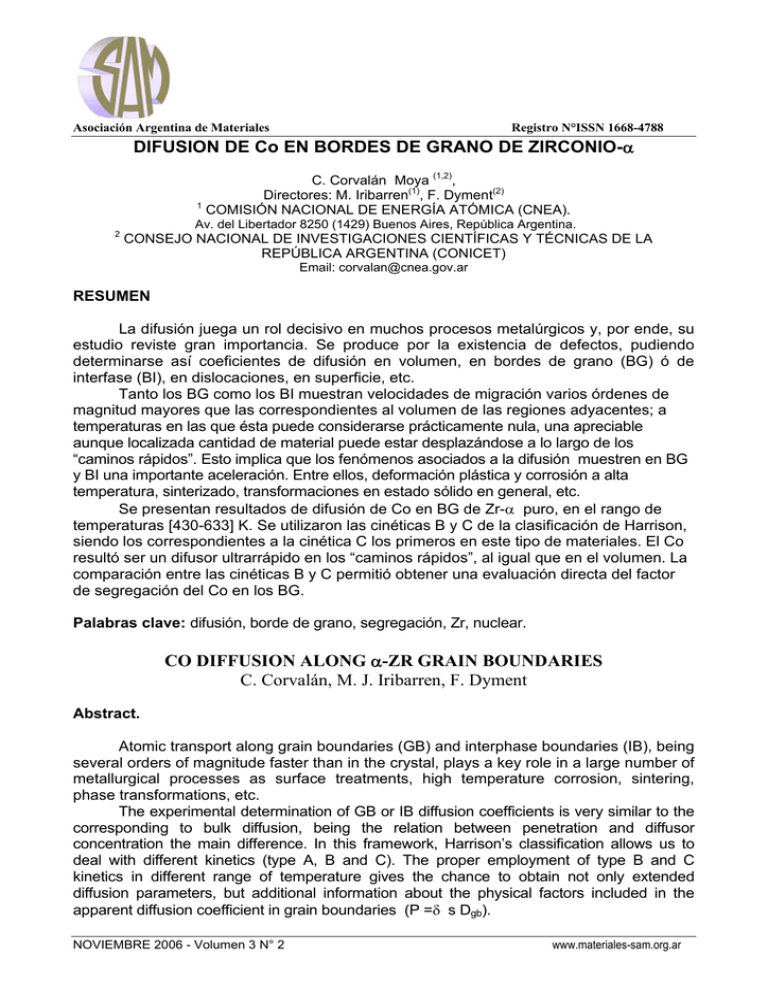DIFUSION DE Co EN BORDES DE GRANO DE ZIRCONIO-
Anuncio

Asociación Argentina de Materiales Registro N°ISSN 1668-4788 DIFUSION DE Co EN BORDES DE GRANO DE ZIRCONIO-α C. Corvalán Moya (1,2), Directores: M. Iribarren(1), F. Dyment(2) 1 COMISIÓN NACIONAL DE ENERGÍA ATÓMICA (CNEA). Av. del Libertador 8250 (1429) Buenos Aires, República Argentina. 2 CONSEJO NACIONAL DE INVESTIGACIONES CIENTÍFICAS Y TÉCNICAS DE LA REPÚBLICA ARGENTINA (CONICET) Email: [email protected] RESUMEN La difusión juega un rol decisivo en muchos procesos metalúrgicos y, por ende, su estudio reviste gran importancia. Se produce por la existencia de defectos, pudiendo determinarse así coeficientes de difusión en volumen, en bordes de grano (BG) ó de interfase (BI), en dislocaciones, en superficie, etc. Tanto los BG como los BI muestran velocidades de migración varios órdenes de magnitud mayores que las correspondientes al volumen de las regiones adyacentes; a temperaturas en las que ésta puede considerarse prácticamente nula, una apreciable aunque localizada cantidad de material puede estar desplazándose a lo largo de los “caminos rápidos”. Esto implica que los fenómenos asociados a la difusión muestren en BG y BI una importante aceleración. Entre ellos, deformación plástica y corrosión a alta temperatura, sinterizado, transformaciones en estado sólido en general, etc. Se presentan resultados de difusión de Co en BG de Zr-α puro, en el rango de temperaturas [430-633] K. Se utilizaron las cinéticas B y C de la clasificación de Harrison, siendo los correspondientes a la cinética C los primeros en este tipo de materiales. El Co resultó ser un difusor ultrarrápido en los “caminos rápidos”, al igual que en el volumen. La comparación entre las cinéticas B y C permitió obtener una evaluación directa del factor de segregación del Co en los BG. Palabras clave: difusión, borde de grano, segregación, Zr, nuclear. CO DIFFUSION ALONG α-ZR GRAIN BOUNDARIES C. Corvalán, M. J. Iribarren, F. Dyment Abstract. Atomic transport along grain boundaries (GB) and interphase boundaries (IB), being several orders of magnitude faster than in the crystal, plays a key role in a large number of metallurgical processes as surface treatments, high temperature corrosion, sintering, phase transformations, etc. The experimental determination of GB or IB diffusion coefficients is very similar to the corresponding to bulk diffusion, being the relation between penetration and diffusor concentration the main difference. In this framework, Harrison’s classification allows us to deal with different kinetics (type A, B and C). The proper employment of type B and C kinetics in different range of temperature gives the chance to obtain not only extended diffusion parameters, but additional information about the physical factors included in the apparent diffusion coefficient in grain boundaries (P =δ s Dgb). NOVIEMBRE 2006 - Volumen 3 N° 2 www.materiales-sam.org.ar Asociación Argentina de Materiales Registro N°ISSN 1668-4788 In this work, diffusion parameters of Cobalt along grain boundaries of pure α-Zr are presented. In order to cover a range of temperature of technological interest, the interval [430-633]K was studied. Suzuoka and Gaussian solutions for type B and C kinetics were employed. The results show that Co behaves as an ultra-fast diffusor. Comparison between B and C kinetics allows us to estimate the segregation factor, its temperature dependence and hence, to obtain the true value for Dgb even in the range of temperature where only P is available. Keywords: diffusion, grain boundaries, segregation, Zr, nuclear NOVIEMBRE 2006 - Volumen 3 N° 2 www.materiales-sam.org.ar